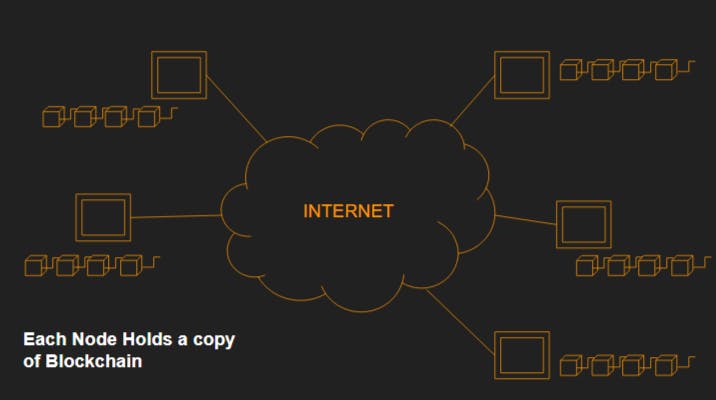Blockchain for Newbies
Blockchain for Newbies is a guide for those who are new to the technology.
From your driver to your stockbroker buddies, everyone is talking about Bitcoin these days. Don't worry, this isn't another post about how to make money using Bitcoin. However, I will try to explain the underlying technology that makes Bitcoin operate, as well as how the blockchain concept can be useful in the future.
A Brief History
Satoshi Nakamoto, an unidentified individual or group, issued a white paper on October 31, 2008, explaining a revolutionary technique to sending money directly from sender to receiver without the use of financial intermediaries. This concept was given a name in the paper: Bitcoin. Because Bitcoin is based on cryptographic principles, it is classified as a cryptocurrency. Bitcoin was created solely for financial transactions, but researchers discovered that its underlying technology can be used to create other safe and robust applications that can transform how current systems operate. This core technology was given the moniker "blockchain." Are there a lot of technical terms? Let's keep things simple!
What is Blockchain and How Does It Work in the Real World?
Assume you live in a city with a large parking lot that can accommodate 200 cars at a time (assume that the parking space just has a ground floor). This parking space features a main gate that is always secured and only opens when a vehicle enters or exits. Now let's look at this single parking structure from various perspectives —
Price: Because this parking space was developed exclusively for parking reasons and the owning company will shoulder all maintenance costs, there will be a hefty rental rate for renting out a single parking space.
Security: If thieves gain entrance to the main door, they can easily gain entry to your car (and remove its wheels, fuel, brakes, or anything else!)
Limit: What if your city's car population doubles from 200 to 300? The parking area will be insufficient to accommodate all vehicles, necessitating the construction of an additional parking space by a private entity.
Trusted: You put your faith in the parking space company, and they are in charge of security and reliability.
consolidated: We can call it a consolidated parking because all of the cars are housed in one building.
Let's change the current scenario now. Consider the following scenario: your city has 200 residences, each with two garages. To make things easier, let's pretend that each residence just has one car (all cars filling up all the slots of big parking space described above). So, out of the two garages accessible, each house has one empty garage. Let's imagine the city's residents decide to rent out the extra garage to anyone in need of a parking spot. This kind of parking space provision will address the issue of parking 200 or more cars (in the event that people move in and out of the city) without the requirement to construct a single larger parking space for the entire city. Let's look at this case in the same way we looked at the prior one.
Price: Because the second garage was not created solely for the purpose of renting, and because the cost of upkeep will be minimal, the cost of renting that extra space will be inexpensive in comparison to the large central parking area.
Security: Because each car is locked in its own garage, robbers will have to open all of the garages in order to gain access to the automobiles, increasing security. (Security on blockchain is a little different, but for the sake of simplicity, let's think of it this way!)
Limit: As the number of houses grows, and each new house comes with extra garage space, the amount of room available to store more automobiles will expand as well. As a result, the network of lessees and lessors grows.
Trustless: Because there is no central authority controlling these distributed parking spots, we expect that all of the participating garage owners will have certain rules in place for renting out their spaces.
Decentralized: As previously said, these parking places are dispersed throughout the city, so we can classify them as decentralized parking.
The comparison above lays the groundwork for comprehending the Blockchain's actual technical infrastructure.
From the Parking Model to the Technical Model
The parking model gives a high-level overview of Blockchain in everyday terms. Now let's see whether we can match the components of our parking scenario to the actual technical model —
The large central parking is managed by a centralized system such as AWS, Google Cloud, and others (these cloud platforms are also distributed at some level but for the sake of simplicity, we will assume them to be a single entity). The data and applications are the automobiles. Blockchain is a decentralized mechanism that allows for distributed parking.
Wait! Something was left out.
Blockchain does not apply to all decentralized systems!! Yes, Blockchain is a specific form of decentralized system with a distinct feature. What is the name of the property? Let's have a discussion about it.
Blockchain is made up of "blocks."
Let's go back to our dispersed parking example and make a minor modification. Assume that a garage's lock is generated when a car is parked inside (we assume that the same car goes to the same parking everyday). Assume that all of the distributed garages have been numbered in sequential order. The lock-key pair for garage #40 is dependent on the lock-key pair for garage #39, as well as the characteristics (such as color, weight, and engine number) of the car parked within garage #40, and this procedure begins with garage #1 and continues to garage #400 or higher.
"The lock-key pair for each garage is determined by the garage's car features and the preceding garage's lock-key pair"
As a result, if a thief tries to break into garage #49 and modifies any feature of the car, such as its color or registration number, the features of the car in garage #39 will change, resulting in the generation of a new lock-key pair for garage #39, and because lock-key pair for garage #40 is dependent on lock-key pair for garage #39, lock-key pair for garage #40 will also change, and so on for future garages.
Let's make one further assumption: constructing a lock-key pair takes a lot of processing resources, so if we have to recompute these pairings in the event that a thief changes any car feature in any garage, it will be nearly impossible to do so.
What happens if the lock-key combination is altered?
Do you recall that we discussed the need of all garage owners adhering to a set of rules? Checking for a legitimate garage is one of these rules. A garage is legitimate if its lock-key pair can be validated, and if any lock-key pair is modified, the lock-key pairs of all subsequent garages become invalid, as each pair is dependent on the previous pair. (The process of validating a lock-key pair for a certain garage is far faster than generating one.)
This dependency of one pair on the preceding pair creates a chain of garages, and these garages are referred to as "blocks" in the technical world, hence the term — Blockchain (a chain of blocks).

Blocks in Blockchain are linked to one other via hashes, similar to how lock-key pairs are linked in our example. Similar to the garage example, if data in one block is changed, hashes for all subsequent blocks must be computed, which is essentially difficult to perform because calculating the hash is an extremely resource demanding operation. As a result, the network rules out the invalidated block. Mining is the process of calculating hashes, and we'll go over it more in the future installment of this series.
How do the blocks recover after being modified?
Every computer in the blockchain network has a copy of the entire blockchain, so if one block or one complete chain is modified on one computer or multiple computers, the entire network compares it to their own copies of the full chain.

If the updated chain is found to be invalid by a majority of the network's nodes (or computers), the modified chain is replaced with a valid chain from other nodes. As a result, Blockchain is vulnerable to a 51% attack. To put it another way, if more than 50% of the nodes on a network are malicious (or have a changed chain), the entire network can be compromised.
Conclusion
Woah!! That was a lot of material to take in. This was the first section of the comprehensive beginner's guide, which laid the groundwork for Blockchain. I hope this post has prepared you for a fruitful debate about Blockchain with your friends.

